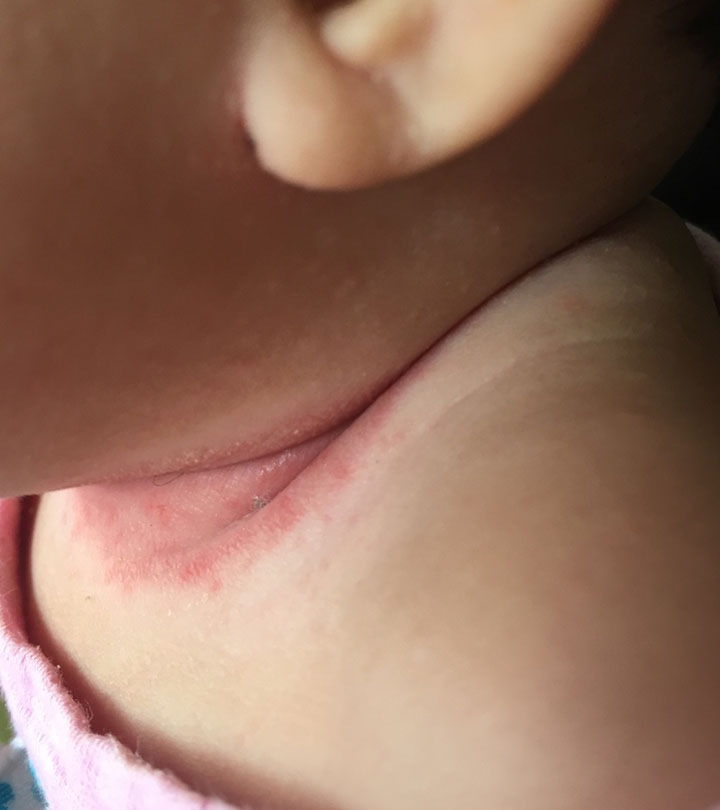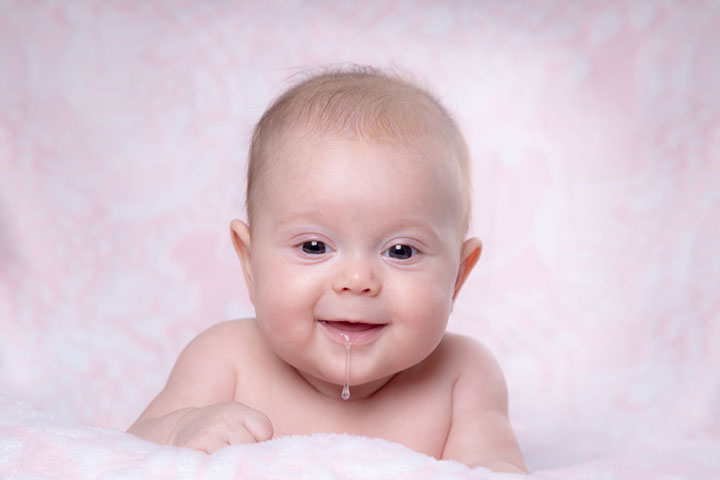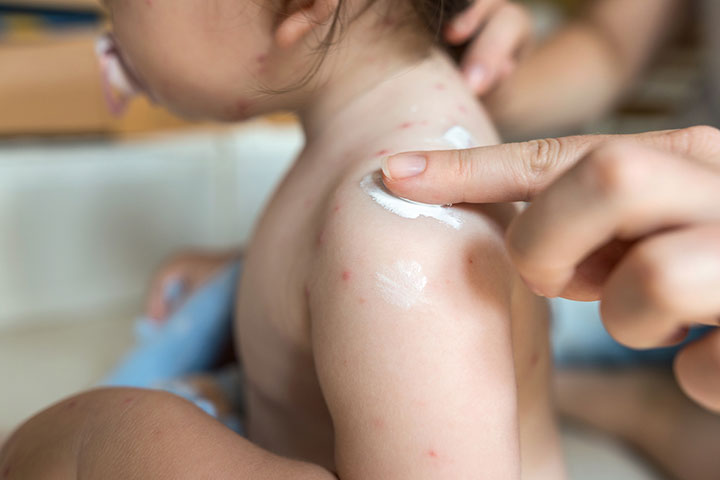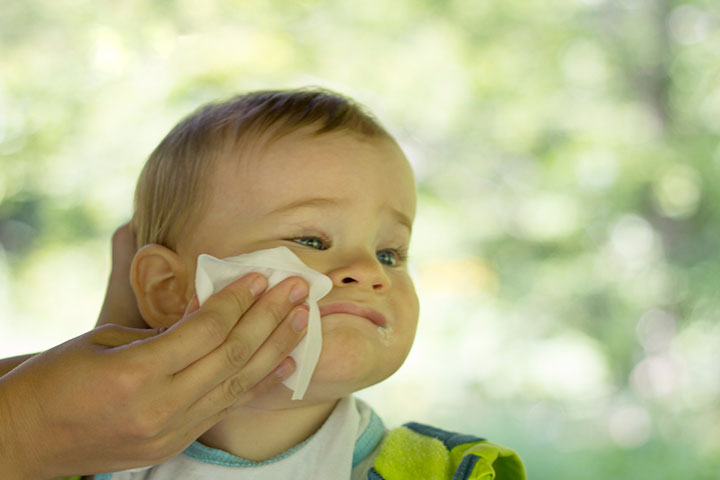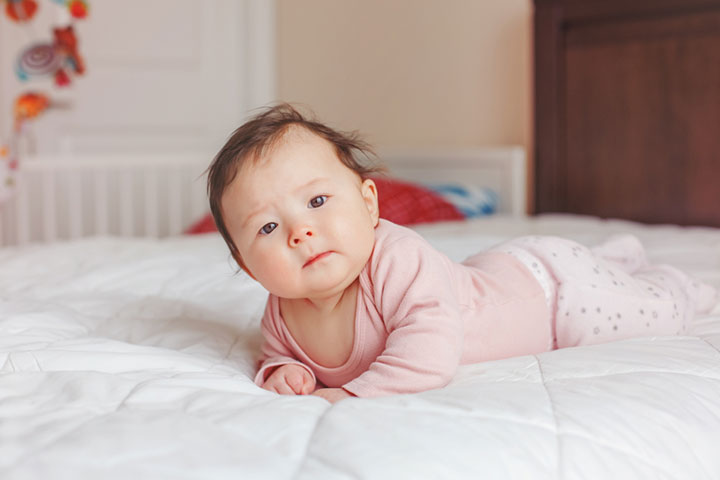The appearance of baby neck rash is fairly common. Although it is harmless and may not be quite apparent, it requires attention due to the baby’s sensitive skin. This, primarily temporary condition, occurs because a newborn generally goes through several dermatological issues within the first few weeks after birth (1), with rashes being one of the problems. This type of rash may typically be the result of contact dermatitis. In this post, we have put together all the necessary information about rashes on a baby’s neck, including their causes, symptoms, treatments, and preventive measures. Read on.
Causes Of Rashes On A Baby’s Neck
Neck rash in babies, a form of allergic or irritant dermatitis, looks like little bumps on the skin. These bumps may appear red, especially in babies with light skin color. This skin condition can have different causes, such as:
- Milk trickle: Babies, while feeding, either from the bottle or from the breast, tend to spit some milk out from the sides of their mouth. This trickled milk gets collected in the skin folds of the neck. If not cleaned properly, the trapped moisture creates a damp environment that becomes a breeding ground for microbial infections (2). It also works with friction and becomes another cause for rash development.
- Drool: Drooling is a common developmental feature in babies and becomes apparent at three to six months of age (3). This drool often travels all the way down from mouth to the skin folds in the neck region. When not cleaned promptly, this deposition of moisture in the skin folds can cause a skin rash due to friction and microbial infestation. Zariah Alexandria, a mother, shares how her baby developed a rash on his neck, “I guess when babies dribble a lot, they may develop a neck rash. Zach has been drooling a lot, maybe because he is teething. A lot of drool accumulates in his neck area, which may have caused the neck rash (i).”
- Prickly heat: Also known as heat rash, this skin rash commonly occurs during the summer season, affecting the neck and other regions of the body. These rashes appear as tiny red itchy skin bumps. (4). The leading cause of heat rash is persistent sweating in infants, which gets trapped in the skinfolds. Besides, the extreme dry heat of summer can irritate your baby’s tender skin. Heat rash may also develop during winters if your baby has too many layers of clothing (5).
- Friction: A baby’s neck is short and tends to have folds too. These skin folds tend to be thicker when the baby is chubby and may constantly rub against each other and cause friction. Constant friction and moisture due to sweating may lead to a neck rash. This rash keeps recurring in babies till they learn to lift their heads without any support (which may take a few months). Dr. Simoni Baid, a Miami, Florida-based holistic physician, says, “Babies have healthy fat (brown fat) on their body. This causes them to have neck rolls. The neck rolls catch humidity in them, which is a breeding ground for bacteria and yeast. Therefore, it is normal for babies to get rashes under their neck.”
As the causes are different, the symptoms that accompany neck rashes in babies also differ and could be highly case-specific. Yet, there are some basic symptoms which are generic and will be noticed in most babies. Read on to know more about it.
Symptoms Of Rash On Your Baby’s Neck
The most common symptoms are itching, accompanied by pain. These symptoms may cause irritation, and the baby may lose their appetite. Although harmless, this condition becomes a matter of concern for parents. Listed next are a few remedies that might provide some relief.
Home Remedies To Reduce Rashes On The Baby’s Neck
As mentioned earlier, most cases of skin rash in babies tend to disappear on their own within a few days. They may not require any treatment or the use of rash remedies. But they can make the baby highly uncomfortable during this period, due to continuous burning and itching sensations. Here are a few things you can do to alleviate the discomfort of the baby.
- Use light and breathable fabrics: Never use stiff, uncomfortable, and heavy dress material for your baby. Always look for lightweight and breathable fabric like cotton. On a hot summer day, you can dress up your baby in a diaper and cotton top. Never wash your baby’s clothes using strong bleach and detergent. These harsh chemicals may cause skin irritation and lead to rashes.
- Apply skin creams and lotions to your baby’s rash: Remember to consult your baby’s pediatrician before you use any topical creams and lotions on your baby, especially younger than six months of age to rule out the possibility of an allergic reaction. For extra caution, you can also do a patch test by applying the cream on the baby’s elbow first. Wait and check for any symptoms If there are no symptoms, use the cream on the affected area.Dr. Baid recommends, “Apply a zinc-based cream to help the skin heal faster. You may also apply Vaseline as it provides a strong barrier to the skin and prevents friction between the neck rolls. It doesn’t treat the rash, but prevents it from getting worse.”
Alexandria further adds, “The pediatrician recommended vaseline, but that was taking too long to work, and I didn’t want to wait too much. I used a diaper rash cream containing castor seed oil and organic beeswax. By the third day of application regularly, I started to see results.”
- Use breast milk: “Breast milk has IgA and IgG antibodies in it. So, if there is a yeast neck rash, breast milk will not help, but if it’s a bacterial or irritation rash, breast milk application may help,” Dr. Baid adds.
- Sprinkle cornstarch: A study published in The Journal of Pediatric Dermatology suggests that cornstarch does not enhance the growth of yeasts on human skin and protects against frictional injury (6). So, you can try sprinkling cornstarch on your baby’s neck before taking them outdoors or after a bath. It may keep the neck region dry and moist-free and reduce the risk of fungal infection-induced rash. But do consult the doctor about it first.
- Try Oatmeal: A research study published in The Journal of Clinical, Cosmetic, and Investigational Dermatology showed that colloidal oatmeal is a safe and effective ingredient in personal care products. It might be particularly effective to ease dry and itchy skin (7). You can try adding oats in your baby’s bath. Also, you can try oat extract to soothe your baby’s skin.
- Use Cold compress: You can try using a cold compress on the affected region to soothe the skin inflammation. Take a tub of ice-cold water and soak a clean washcloth. Apply this to the affected region for 5-10 minutes to soothe inflamed skin. Once done, pat the area dry. You can repeat the procedure as and when needed.
- Maintain skin hygiene: If you follow regular bathing and good hygiene practice for your baby, you may be able to prevent these skin rashes.
- Use boiled or distilled water: Remember to use boiled or distilled water to bathe your baby. This will ensure that the bathing water doesn’t contain any harmful microbes that may otherwise harm.
- Massage with coconut oil: You can also try massaging your baby with coconut oil twice a day for relief from symptoms. Due to its emollient and anti-microbial properties, coconut oil may work as a preventive baby skincare product (8).
When To Call Your Baby’s Doctor?
Your baby’s neck rash may disappear on its own. However, if there is an underlying health condition associated with rash, then you may also notice the following symptoms (9):
- Fever
- Areas that look wet, oozing, or red
- A rash that is worse in the skin creases
- Pus-filled or fluid-filled blisters
- significant scratching
- inconsolable crying
Also, if you notice small red dots or spots that don’t disappear when pressed, you must consult the doctor immediately. These spots may occur due to bleeding under the skin. This condition is known as petechiae and can indicate a serious infection.
Remember that you know your baby better than others. If you notice any skin rash that worries you, don’t hesitate to call a pediatrician for further consultation.
Preventive Measures To Avoid Baby Neck Rash From Occurring
- Bathe your baby regularly and maintain a good baby hygiene practice.
- Select the right fabrics for your baby. Avoid rough fabrics, woolen clothes, and blankets. These are not recommended for babies as they have a sensitive skin type.
- Remember to dry the neck region (and other moisture-prone regions) after bathing your baby, and after every feed.
- Keep your baby’s neck region open and moist-free most of the time. Dry skin prevents the accumulation of moisture in the skin folds. It helps in healing the rashes faster.
- Try to keep your baby in a cool and well-aired room as excessive heat causes perspiration in the skin folds and leads to skin rashes.
- During winters, when woolens cannot be avoided, use the ones that have a wide neck. Make the baby wear a cotton shirt collar underneath the woolens so that wool does not touch the skin.
Baby neck rash is common due to the accumulation of drool or milk between the neck folds. Although it is a harmless condition, it can be concerning to parents. If your baby has developed a neck rash, you may try to put them in comfortable clothing or use dermatologically tested baby lotions to treat the redness. The rashes will subside after following a good skin care regime. Keep the neck clean and try a few home remedies after a doctor’s approval to reduce the rashes. However, if you find the rashes concerning or if your baby develops any other symptoms, it is better to consult a pediatrician.
Key Pointers
- Milk drops, drooling, and friction against the skin can cause skin rashes in babies.
- Keeping the neck area clean and dry is crucial to preventing skin rashes.
- Using light and breathable fabrics, breast milk, cold compresses, and maintaining skin hygiene can help prevent irritation or rashes in babies.
- It is essential to consult a doctor when skin rashes worsen.
Are you wondering when to expect your first period after breastfeeding? Watch this informative video to understand when you should expect your first period while breastfeeding and how to manage it.
